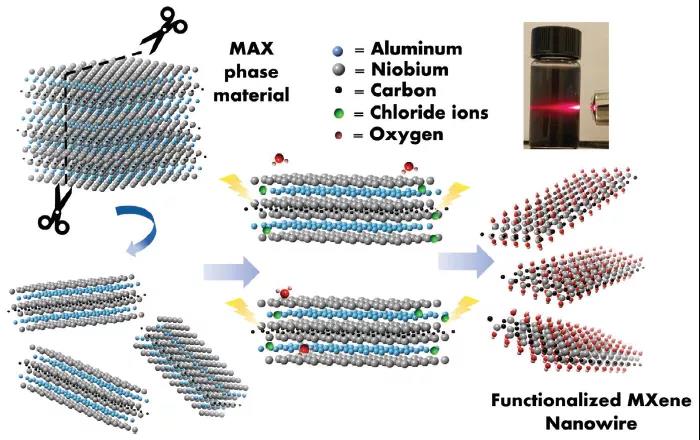Hong Kong Polytechnic University Professor Hao Jianhua‘s team Adv Sci: the first fluorine-free synthesis of Nb2CTx nanowires for high-performance zinc batteries
QQ Academic Group: 1092348845
Detailed
In recent years, two-dimensional materials have attracted great attention in the fields of energy, electronics, and optoelectronics. With good mechanical properties and electrical conductivity, two-dimensional transition metal carbonitrides ( MXenes ) have shown great potential value in the fields of electrochemical catalysis, energy conversion and storage. However, traditional hazardous fluoride synthesis routes and strong interlayer bonding have limited the development of MXenes .
Achievements
Recently, the Hong Kong Polytechnic University ‘s Professor Hao Jianhua in top international journals Advanced Science published entitled "Efficient Energy Conversion and Storage Based on Robust Fluoride-Free Self-Assembled 1D Niobium Carbide in 3D Nanowire Network" paper. A self-assembled synthesis method for one-dimensional MXenes structure that is fluorine-free, simple and fast is introduced . MXene nanowires (NW) not only connect the flexible substrate, but also effectively increase the electrochemically active surface area. The favorable kinetic structure improves the oxygen evolution / hydrogen reaction and zinc ion uptake performance. 1D ‘s MXene NW maintains high stability at lower temperatures, and the over-potential of 236 mV does not separate from the substrate for 24 hours. This flexible zinc ion battery exhibited a power density of up to 420 W kg −1 in 150 cycles . This work has laid a novel and non-toxic route to synthesize one-dimensional MXene nanofiber structures, and has shown broad prospects in multifunctional applications in energy conversion and energy storage.

Figure 1 Schematic diagram of the fluorine-free preparation route of Nb 2 CT x NW .

Figure 2 Nb 2 CT x NW morphology.

Figure 3 Structure of Nb 2 CT x NW .

Figure 4 Electrochemical characterization of Nb 2 CT x NW .

Figure 5 Nb 2 CT x NW zinc ion battery stability test.
in conclusion
In summary, for the first time, a fluorine-free synthesis route - dilute HCl electrolyte was used to synthesize 1D Nb 2 CT x in 4 hours . Successfully prepared a three-dimensional network of one-dimensional nanowire interconnections on the carbon fiber cloth substrate. The carbon fiber cloth not only serves as the skeleton of the nanowire, but also improves the ion accessibility, thereby improving the electrochemical performance of the MXene compound. By optimizing the coupling with transition metal ions, the transition metal / 3D-Nb 2 CT x NWs has extremely low overpotential, exhibits excellent electrocatalytic performance, and is comparable to the best existing metal-based electrocatalyst. In addition, the flexible MXene -based cathode has a power density of up to 420 W kg −1 . This work reported a simple, new, and non-toxic method for preparing different nano-morphology MXene complexes, and demonstrated excellent energy conversion and storage performance. This strategy will also provide a reference for the application expansion of other nanowires and 1D / 3D structures.
Original link:
https://onlinelibrary.wiley.com/doi/full/10.1002/advs.201903680
Source:
- Previous: MXene @ 普鲁士 蓝 Analogs
- Next: MXene breakthrough: Na


 mxene academic
mxene academic
